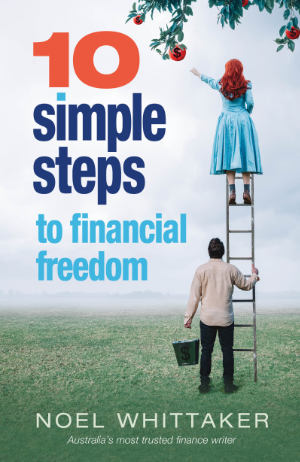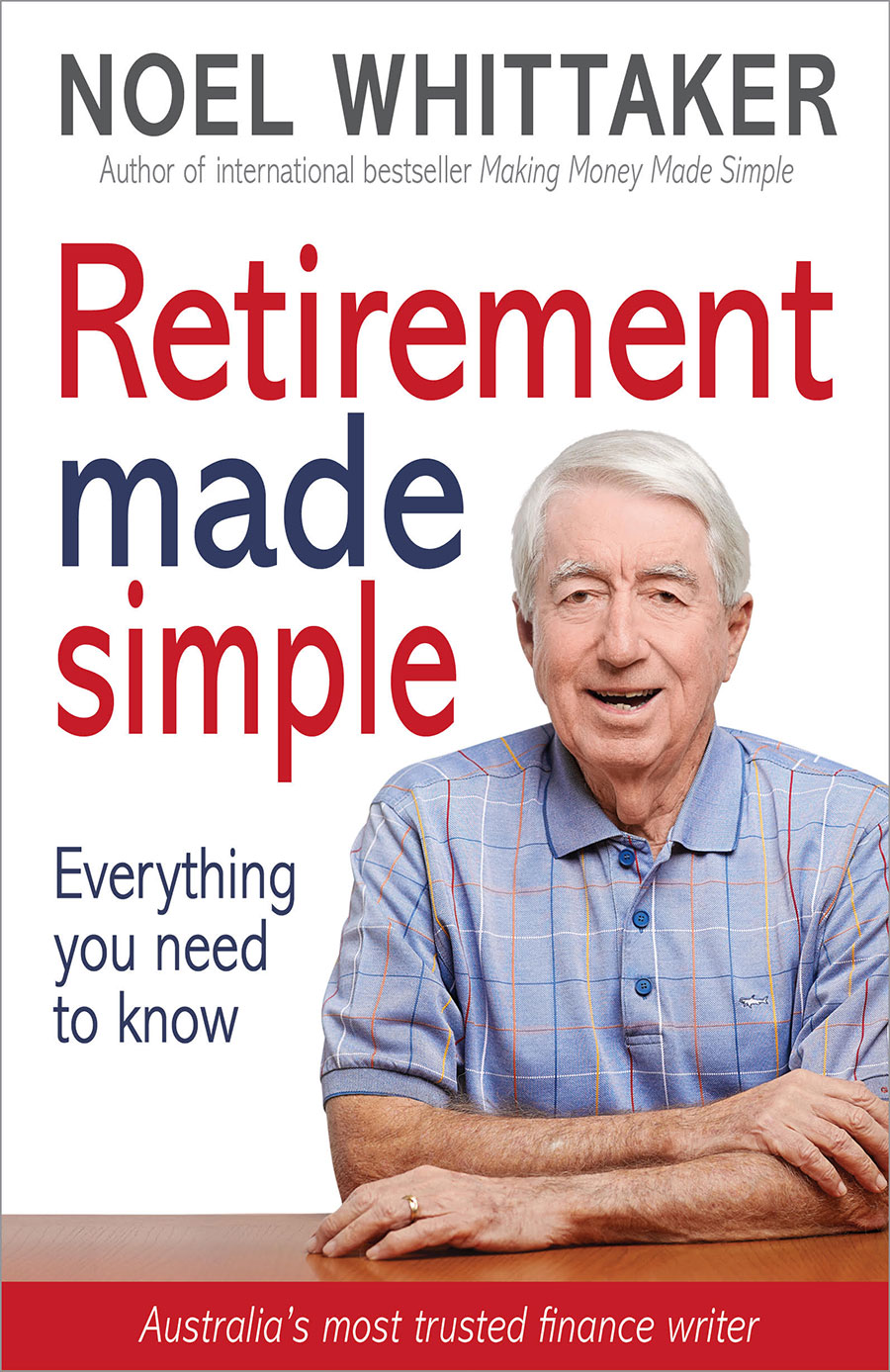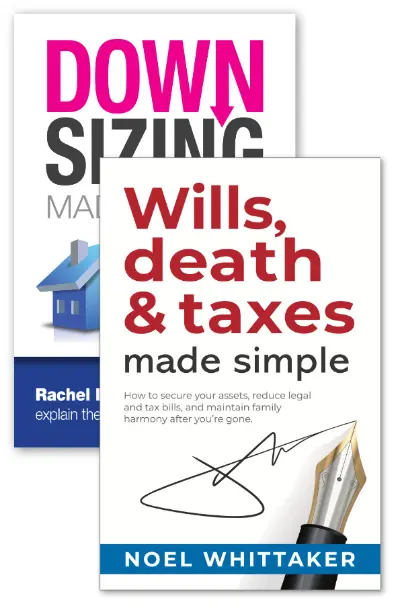
You never overthink good thoughts,
why do you overthink bad ones?
DAVID MELTZER
Welcome to November
In this newsletter, we’re trying something new – an audio edition with a twist. Instead of just reading the newsletter, renowned broadcaster John Deeks and I will be discussing everything covered in the issue.
People’s attention spans are short these days, and a 3,100-word newsletter is a lot to read, yet it still doesn’t allow us to dive deep into the big issues. So, for the first time, we’ll be talking through the topics in detail so you can listen while you’re walking or driving.
Listen now on Spotify or below:
Communication is always evolving, and it’s important to stay up to speed.
You can find this and other great interviews and podcasts on my website here.
In this newsletter
We’ll cover some hot topics: negative gearing and its recent media attention, housing affordability that’s putting homes out of reach for many, and superannuation calculators – tools that are sparking debate but remain confusing to most people. I still believe mine are the best around because they’re straightforward and not designed by bureaucrats.
And with just seven weeks until Christmas, we have to think about books as gifts. Books have always been my top pick for Christmas presents because they’re affordable, last for years, and can make a lasting impact. I don’t know of any other gift that offers such unique value. In the book section, I’ll share a quick guide on great book choices for different age groups.
I often hear things like, “My parents gave me your book when I was 24, and it’s made me a fortune,” or “Just reading your book changed my life. Thank you.” You truly have the power to change a loved one’s life.
Recently, I spoke with a successful fund manager who told me his life changed at 13 when I visited his school to talk about compounding. That was a game-changer for him.
Thanks for joining us this month – let’s dive in!
Negative gearing
Negative gearing is back in the spotlight, with several proposals to alter how property tax deductions work. Suggestions include banning negative gearing for properties altogether or limiting it to just two properties.
Advocates of these changes argue that current rules provide investors with an unfair tax advantage while locking first-home buyers out of the market. But these claims don’t hold water. Negative gearing is not a huge tax loophole. Most property investors fall into the 30% tax bracket, meaning the government covers 30% of any loss, and the investor bears 70%. That’s far from a tax rort. Plus, many of these losses are due to non-cash deductions like depreciation, which are recouped when the property is sold.
It’s crucial to consider how any changes would be implemented. No government heading into an election would eliminate tax deductions for existing rental properties. Any new rules would need to be grandfathered, which would discourage existing investors from selling, and deter potential investors from buying. It’s a zero-sum game. The real cause of the housing un-affordability crisis is unchecked immigration, which is fuelling demand.
 Cartoon by Bob Rich for Hedgeye
Cartoon by Bob Rich for Hedgeye
There’s been much talk about what happened when Paul Keating changed the rules back in 1985, but people seem to forget that interest was still deductible – investors could “quarantine” their rental property losses. While they couldn’t offset these losses against other income to reduce their tax bill in the current year, they could carry forward the losses and apply them to future rental income or capital gains from the sale of the property.
So the losses weren’t completely disallowed: they were deferred. Investors had to wait to benefit from the deductions until they had future rental income or sold the property, at which point the quarantined losses would be used to reduce tax liabilities.
Keating also altered the depreciation rules. He raised the depreciation allowance on buildings from 2.5% to 4%, and extended it to residential properties, which had previously been ineligible. In 1987, when negative gearing was reinstated, the rate was reduced back to 2.5%, but residential properties were allowed to retain 2.5% depreciation.
There’s a larger issue at play. Thanks to the Greens and their supporters, there’s growing resentment toward landlords among certain groups. This has led to onerous new rules, such as requiring landlords to comply with any “reasonable” request from tenants. These requests could include installing air conditioning, fitting security flyscreens, or allowing pets. Such changes make investing in property less attractive.
If there’s a silver lining to the constant attacks on landlords, it’s that it nudges investors to consider shares more seriously. In retirement, shares are far better than property as an investment. You don’t have all the outgoings – like land tax, repairs, and rates – and if you need money, you can simply sell part of your investment and have the proceeds within a week. With property you’re stuck selling the whole asset, which may take months, and often face a large capital gains tax bill.
In most cases, shares outperform residential property too. For example, in 1990, I bought a beachfront apartment for $500,000, which would be worth about $2.5 million today if I still owned it – but I don’t. If I had put that same money into a sharemarket index fund, it would be worth $10.4 million today. As a second example, I recently sold an apartment for $700,000 that cost me $220,000 twenty-two years ago. That same $220,000 invested in the index would now be worth $1.6 million.
Pushing investors out of the property market won’t solve the housing affordability crisis: it will take policies that bring demand and supply into alignment to do that. But creating uncertainty about property taxation may make landlords nervous – if large numbers sell their properties to owner occupiers, rents will go up for the remainder. If not, landlords will try to reduce losses, and rents will go up. As long as demand outstrips supply, housing will remain expensive.
Housing affordability
Housing affordability is shaping up as a major topic as we head toward the next federal election. The numbers are staggering. Ten years ago, the median house price in Sydney was $880,000, and in Melbourne it was $630,000. Today, those figures are $1.7 million and $1,200,000, respectively. This equates to an annual increase of 7.93% for Sydney and 6.8% for Melbourne.
 Cartoon by Bob Rich for Hedgeye
Cartoon by Bob Rich for Hedgeye
Meanwhile, wages have not kept pace. Over the last decade, gross income growth has averaged just 2.18% per year for Sydney and 2.03% for Melbourne. This disparity is continuously widening the gap between the haves and the have-nots. Children of well-resourced parents have been able to enter the market by drawing on the Bank of Mum and Dad, and this demand has driven prices up further, making affordability even harder for those without such support.
The solution is complex, as numerous factors are contributing to the problem. Some of the key factors are a surge in migration putting pressure on rental accommodation, a growing shortage of skilled labour and materials, and militant unions forcing up costs. Add to this bureaucratic delays at all levels of government and the rising cost of regulation, and the situation becomes even more challenging.
Yet another hurdle is mortgage insurance, which is required for buyers with less than a 20% deposit. For example, analysis from Mozo.com.au shows that if you bought an $850,000 property with a 5% deposit of $42,500, the lender’s mortgage insurance fee would be almost $38,000 – nearly as much as your deposit.
To make matters worse, mortgage insurance is not transferable from one lender to another, even though there are only a few providers in the country. This makes it virtually impossible for anyone with less than 20% equity to refinance their property with a different lender on better terms, because they would need to pay for mortgage insurance all over again.
The Coalition proposes a unique scheme that allows homebuyers to invest up to $50,000 or 40% of their superannuation (whichever is less) toward the purchase of a new or established home. I have been dead against previous suggestions to draw on super, because of the long term detrimental effect on people’s balances, but this scheme has a way to deal with that. Participants are required to refund the withdrawn amount, along with any earnings, when the house is sold. The “interest” rate used to calculate the earnings will be tied to the capital growth of the home.
 Image by gpointstudio on Freepik
Image by gpointstudio on Freepik
This scheme will also be available to people who separate later in life, especially to assist women into home ownership, noting the current income and employment gaps compared to men. Participants must live in the property as owner-occupiers for at least 12 months and provide a minimum deposit of 5% of the purchase price, excluding the amount withdrawn from their superannuation. Upon selling the property, they must repay the withdrawn funds along with any proportional gains or losses.
Case Study
Think about Kerry and Sam, both aged 35, who each have $84,000 in superannuation. Through diligent saving, they have scraped together a deposit of $85,000. But if they buy now, they’ll be liable for nearly $21,000 in mortgage insurance, which will be added to their loan and remain a burden for the life of the loan. However, if they chose to withdraw $36,000 each from their superannuation under the proposed Super Home Buyer Scheme, the mortgage insurance would drop to just $6700. If they focused on paying off the mortgage quickly, in a few years they may be able to get the loan to valuation ratio below 80%, and then be free to refinance at a cheaper interest rate. The ability to access their superannuation has saved them over $14,000, which is a massive return on the $72,000 they have borrowed from their super.
This case study shows the benefit of the superannuation access scheme. Using super funds reduces the loan size, improving loan-to-valuation ratios, and potentially improving eligibility, especially if income is limited. And a smaller loan can be paid off faster, using simple techniques like fortnightly repayments.
If the property appreciates by 3% annually and they sell in five years, the $36,000 each has borrowed from super must be repaid, plus a 3% notional interest matching the capital gain. This strategy helps build financial security by reducing loan interest and increasing property equity through capital growth. The coalition needs to add just one feature: make mortgage insurance transferable between lenders. This would be a game-changer.
Superannuation Calculators
Claims that superannuation calculators produce results that are inaccurate or misleading have been in the spotlight lately. It’s not surprising, as there’s little uniformity among the calculators provided by our top super funds’ websites.
But the problem often isn’t about the tool, it’s about the information going into it. The real issue is less likely to lie with the calculators themselves than with the data that users put into them, and with the different assumptions made by developers and users.
 Image by 8photo on Freepik
Image by 8photo on Freepik
Super calculators are provided to help give you a rough idea of how much you might have saved by retirement and whether it will be enough to meet your needs. It’s simple: you enter figures like your current balance, projected contributions, and estimated investment returns, and the calculator estimates your retirement savings.
There are two big factors that will affect your super balance at retirement: investment returns and inflation. These issues are linked, and considering that retirement could be 30 or 40 years away, it’s wise not to take any calculations as gospel truth.
I’ve written at length about the importance of investment returns as superannuation builds over decades using the magic of compounding, so I won’t revisit that here.
Inflation is also critical, and many people underestimate its impact. It slowly eats away at the purchasing power of your money, so that $1 million in 30 years won’t buy what it does today. If inflation averages 4% rather than 2%, the compounding effect of even this small shift could seriously reduce your buying power over a few decades.
 Image by Freepik
Image by Freepik
Most calculators assume you’ll keep your money invested throughout retirement, but many people plan to take a lump sum from their super when they retire, to pay off their mortgage or fund a big purchase like a caravan or a holiday. Removing large amounts of capital early in retirement can significantly reduce the income stream available to you in later years, throwing the calculators’ prediction off track.
Beyond the usual ups and downs of life, another key factor affecting retirement plans is the age pension you might qualify for. I’ve seen articles suggesting you don’t need as much for retirement as once thought, because the age pension is available as a safety net, and this is also not usually included in superannuation calculators. For instance, a couple retiring today with $470,000 in assessable assets – including $430,000 in super – could qualify for a combined annual pension of $44,855. However, if your super performs well and the income you draw is below your returns, your balance may grow, potentially reducing your pension.
On the flip side, if you draw down your assets, your pension might increase as your assets decrease. In any event who knows what pension may be available in 30 years as rising life expectancies stretch government budgets
Calculators can be valuable tools in your retirement planning, if you understand how to use them effectively. Ideally, they provide a foundation for calculating your contributions and assessing whether you need to bolster your savings. But this isn’t a set-and-forget exercise: the key is to stay proactive and adjust as needed.
Ideally, your retirement planning should follow a clear, structured process. First, decide when you’d like to retire, and create a budget to estimate how much you’ll need to spend once you do. Next, assess your current assets and consider options like downsizing your home to free up equity, or potential inheritances that may come your way. Then use a retirement calculator to see whether your existing income and assets will be sufficient, or if you need to implement additional strategies to reach your goals. Each year, review your net worth, revisit your goals, and adapt your strategies as circumstances evolve.
And of course, my calculators are the best there is.

Choosing the Right Book
On my website, you’ll find a dedicated section that suggests books based on age brackets. Here’s a quick guide:
 For ages 12 to 18
For ages 12 to 18
Ten Simple Steps to Financial Freedom is a fantastic choice. This smaller book in full colour is an easy read, perfect for young people new to money concepts.
It covers the basics—don’t spend more than you earn, keep building your skills, and understand the magic of compounding.
 For ages 18 to 40
For ages 18 to 40
Making Money Made Simple is ideal.
With over two million copies sold, the latest editions are packed with actionable steps, goals, and practical advice—not just information.
Buy Now
 For those over 40
For those over 40
Retirement Made Simple is a great starting point, especially with its recent updates to reflect the new superannuation and age pension figures.
It explains investing principles and covers everything you need for a happy, fulfilling retirement. The last 60 pages on happiness and health are worth the cost of the book alone.
Buy Now
 And for older readers
And for older readers
We recommend Wills, Death and Taxes Made Simple and Downsizing Made Simple.
Keep in mind that one of the main features of these books is for you to avoid to all the traps involved. Remember, at the later stages in life you can’t afford to make a major error and lose hundreds of thousands of dollars.
Free shipping on all Bundles
When you buy from our website bundles are the way to go. Postage is our biggest cost, but if you buy two or more books, we cover it. Between postage, GST, and other expenses, selling books isn’t about profit; the real reward is seeing the impact these books have on people’s lives.
A personal touch
 We know how much people love to get books personally autographed which is not physically possible giving the books are shipped from the warehouse.
We know how much people love to get books personally autographed which is not physically possible giving the books are shipped from the warehouse.
However, I’ll do this Christmas what I did last Christmas – we will enclose in every book bought before Christmas a pre-gummed sticker with my signature which you can make out to the recipient. I’m sure that will be most appreciated.
Ebooks
Or, if you want to collect and read my books my on your phone, laptop, Ipad or Kindle, I also offer Ebook versions of all my best selling titles so you can conveniently carry them around in your pocket.
Ages 12-18
Ten Simple Steps to Financial Freedom Ebook – click here to buy
Ages 18-40
Making Money Made Simple Ebook – click here to buy
Age over 40
Retirement Made Simple Ebook – click here to buy
Older Readers
Wills Death and Taxes Made Simple Ebook and
Downsizing Made Simple Ebook

And finally

They’re back! Those wonderful Church Bulletins!
Thank God for the church ladies with typewriters.
These sentences actually appeared in church bulletins or were announced at church services:
The Fasting & Prayer Conference includes meals.
—————–
Scouts are saving aluminium cans,
bottles and other items to be recycled.
Proceeds will be used to cripple children.
—————–
The sermon this morning: ‘Jesus Walks on the Water’
The sermon tonight: ‘Searching for Jesus’
—————–
Ladies, don’t forget the rummage sale.
It’s a chance to get rid of those things
not worth keeping around the house.
Bring your husbands.
—————–
Don’t let worry kill you off
– let the Church help.
—————–
Miss Charlene Mason sang ‘I will not pass this way again’, giving obvious pleasure to the congregation.
—————–
For those of you who have children and don’t know it, we have a nursery downstairs.
—————–
Next Thursday there will be try-outs for the choir.
They need all the help they can get.
—————–
Irving Benson and Jessie Carter were married on October 24 in the church.
So ends a friendship that began in their school days.
—————–
At the evening service tonight the sermon topic will be ‘What Is Hell?’
Come early and listen to our choir practice.
—————–

—————–
Eight new choir robes are currently needed due to the addition of several new members and the deterioration of some older ones.
—————–
Please place your donation in the envelope along with the deceased person you want remembered.
—————–
The church will host an evening of fine dining, super entertainment and gracious hostility.
—————–
Pot-luck supper Sunday at 5:00 PM – prayer and medication to follow.
—————–
The ladies of the Church have cast off clothing of every kind.
They may be seen in the basement on Friday afternoon.
—————–
This evening at 7PM there will be a hymn singing in the park across from the Church.
Bring a blanket and come prepared to sin.
—————–
The pastor would appreciate it if the ladies of the Congregation would lend him their electric girdles for the pancake breakfast next Sunday.
—————–
Low Self Esteem Support Group will meet Thursday at 7 PM.
Please use the back door.
—————–
The eighth-graders will be presenting Shakespeare’s Hamlet in the Church basement Friday at 7 PM.
The congregation is invited to attend this tragedy.
—————–
Weight Watchers will meet at 7 PM at the First Presbyterian Church.
Please use large double door at the side entrance.
—————–
The Associate Minister unveiled the church’s new campaign slogan last
‘I Upped My Pledge – Up Yours!’
 I hope you have enjoyed the latest edition of Noel News.
I hope you have enjoyed the latest edition of Noel News.
Thanks for all your kind comments. Please continue to send feedback through; it’s always appreciated and helps us to improve the newsletter.
And don’t forget you’ll get more regular communications from me if you follow me on X – @NoelWhittaker.
Noel Whittaker

